2 Coordinate Systems
Physics is about using math to predict how objects will move. Before we describe motion, however, we must first be able to describe an object’s position. We do this using a coordinate system. Let’s see how this works:
Some key points to emphasize::
- You can choose any point as the origin of your coordinate system.
- The address for a point
 is
is  .
.  is referred to as the x-coordinate, and
is referred to as the x-coordinate, and  is the y-coordinate. Starting from the origin:
is the y-coordinate. Starting from the origin:
 is the number of steps to the right/left we must take to get to
is the number of steps to the right/left we must take to get to  .
.- If
 is positive, we move right; if negative, we left.
is positive, we move right; if negative, we left.  is the number of steps up/down we must take to get to
is the number of steps up/down we must take to get to  .
.- If
 is positive, we move up; if negative, we move down.
is positive, we move up; if negative, we move down.
Let’s try some quick exercises to make sure we’re all in the same page.
Exercise 2.1: Reading Positions from a Graph
The plot below shows two possible origins, labelled “1” (orange) and “2” (blue). What are the coordinates of Aisha, Beth, and Charlie for these two different origins? Assume that the grid uses units of meters, so that each grid cell is 1 meter to a side.

Key Takeaways
Given a coordinate system, a point ![]() that is
that is ![]() grid cells to the right of the origin, and
grid cells to the right of the origin, and ![]() grid cells up from the origin, has coordinates
grid cells up from the origin, has coordinates ![]() .
.
